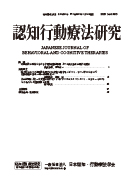Volume 46, Issue 1
Displaying 1-3 of 3 articles from this issue
- |<
- <
- 1
- >
- >|
Review
-
2020 Volume 46 Issue 1 Pages 1-14
Published: January 31, 2020
Released on J-STAGE: October 23, 2020
Download PDF (487K)
Practical Researches
-
Effects of Behavioral Therapy on Habit Reversal in an Adult Female Client Presenting with Vocal Tics2020 Volume 46 Issue 1 Pages 15-23
Published: January 31, 2020
Released on J-STAGE: October 23, 2020
Download PDF (625K) -
2020 Volume 46 Issue 1 Pages 25-36
Published: January 31, 2020
Released on J-STAGE: October 23, 2020
Download PDF (718K)
- |<
- <
- 1
- >
- >|
